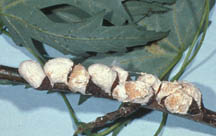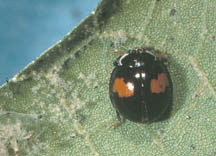Cottony Maple Scale | |
|---|---|
| June 19, 2006 | |
There are reports that cottony maple scale (Pulvinaria innumerabilis) is present in northern Illinois. This scale is primarily established in the northern portion of Illinois—north of I-72. Cottony maple scale is one of the largest soft scales and attacks a number of ornamental trees, including silver maple, red maple, sugar maple, honey locust, black walnut, hackberry, and linden. Silver maple, however, is one of the most susceptible hosts. In fact, this scale may cause branch dieback of silver maple. However, in most instances, the only “true” damage is the large quantities of honeydew produced. At this time of year, relatively little can be done to control cottony maple scale. At this point, the scales are red–brown in color and 1/4-inches in diameter, appearing as round bumps on twigs and branches. They feed within the vascular tissues, using their piercing–sucking mouthparts to withdraw plant fluids containing nitrogen and water, and excreting the excess as honeydew, which is a clear, sticky liquid that covers tree branches, sidewalks, and cars located under infested portions of the tree. If trees are heavily infested, it appears as if it is “raining” honeydew. In addition, honeydew is an excellent growing medium for black sooty mold fungi, which may reduce the aesthetic appearance of infested trees. In early June, females produce a white, spherical egg mass about 3/8 inch in diameter. Branches may appear to be covered with popcorn during heavy infestations. Eggs hatch into crawlers around mid-July, when Queen Anne’s lace (Daucus carota) and elderberry (Sambucus canadensis) are blooming. The crawlers, or first-instar nymphs, are flattened, oval, translucent, and tan-colored, appearing as specks moving on twigs and leaves. The crawler stage is capable of dispersing to other susceptible host plants. Crawlers orient themselves so that their posteriors are facing into the wind and then they raise their abdomens and hind legs upright. This allows them to be carried on air currents to other plants. The crawlers have also been reported to climb onto the feet of birds and take a “free flight” (no frequent-flyer miles here!) to another host plant. The crawlers, after several weeks, settle down on leaf undersides, primarily along the midrib, eventually molting to the next nymphal stage, which appears as elongated, oval brown bumps 1/16 to 1/8 inch long. Crawlers retain their legs, which allow them to migrate back onto twigs as leaves begin to drop during fall. While on the twigs, they molt into a legless stage. Cottony maple scale overwinters as a mated female. There is one generation per year in Illinois.  Cottony maple scale is susceptible to numerous natural enemies, in particular, the twice-stabbed lady beetle (Chilocorus stigma). This beetle is black, round, and about 1/8 inches long. A large red spot is present on each of the wing covers, which is how the insect received its name. Females lay eggs that hatch into gray to white, fuzzy larvae that are 3/16 inch in length, resembling the egg mass of cottony maple scale. Beetle larvae move very slowly and have a yellowish underside. The larvae are easily seen with a hand lens. The larvae and adult stages of the twice-stabbed lady beetle feed on all stages of the cottony maple scale, including eggs, crawlers, older nymphs, and adults. Another effective predator is the Asian lady beetle (Harmonia axyridis), which is more arboreal (living in trees) in its habitat than the native ladybird beetle species. This beetle is orange–red in color, and the abdomen is covered with 19 spots. The Asian lady beetle is the same beetle that enters residential and commercial buildings during late fall and early winter causing people “undue” stress. As with any natural enemy, population increases of the twice-stabbed lady beetle are contingent on cottony maple scale population increases. If scale populations increase at a rate such that the beetles cannot keep up then damage and honeydew will be noticeable. However, if the beetles (both adults and larvae) are abundant, then they may consume enough scales so that an insecticide application is not warranted. If insecticide applications are performed during this time, then the beetles will be killed and the scale population rapidly increase to damaging levels. Insecticides recommended for control of cottony maple scale include acephate (Orthene), bifenthrin (Talstar), cyfluthrin (Tempo), insecticidal soap, and horticultural (= summer) oil. These insecticides need to be applied when the crawlers are active to achieve maximum control of cottony maple scale and alleviate problems next year. Repeat applications may be needed 10 days following an initial application. It is important to note that acephate (Orthene) should not be used to control cottony maple scale on red or sugar maple due to the potential for plant injury (= phytotoxicity). | |
| Author: | Raymond A. Cloyd |
